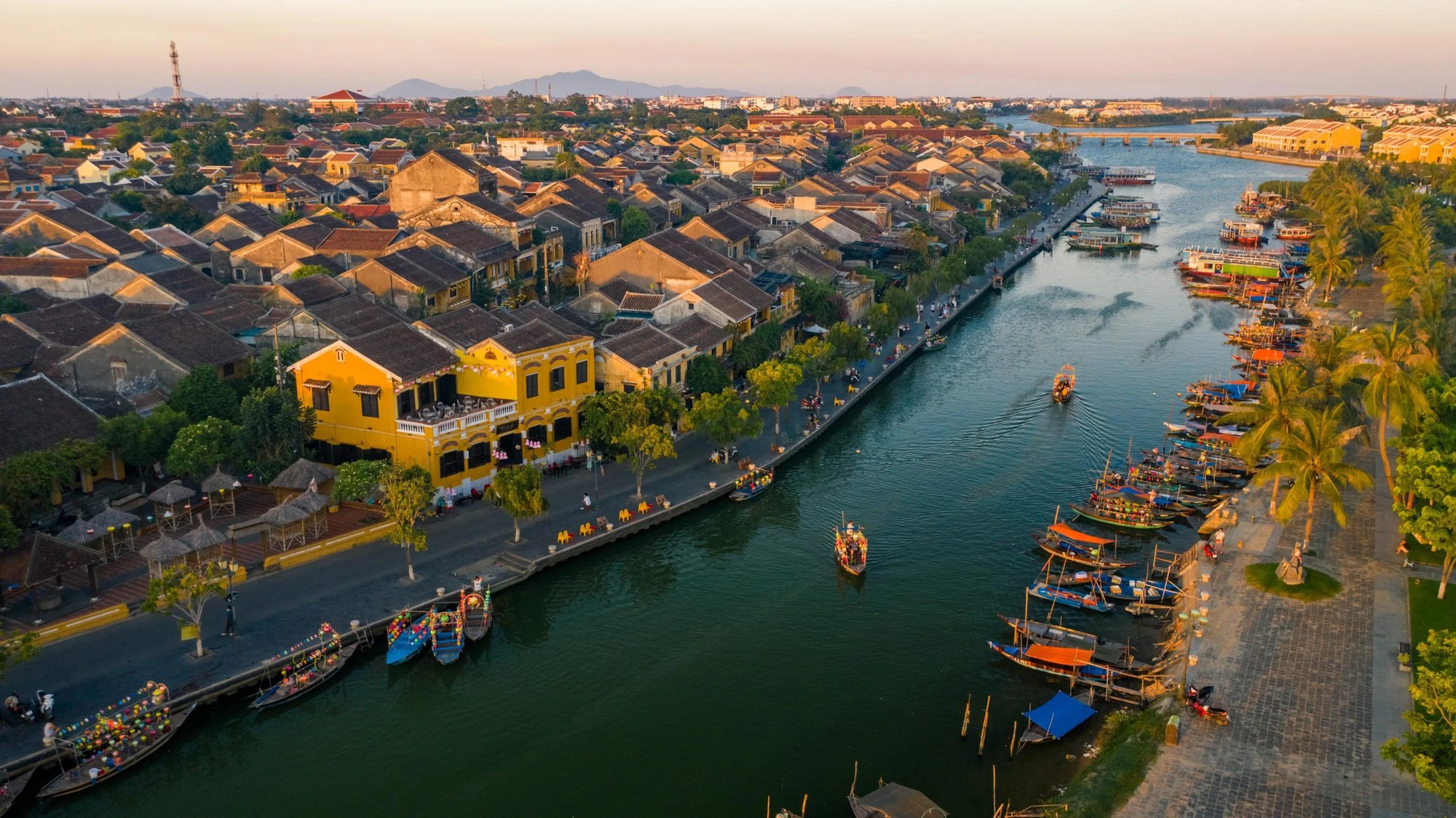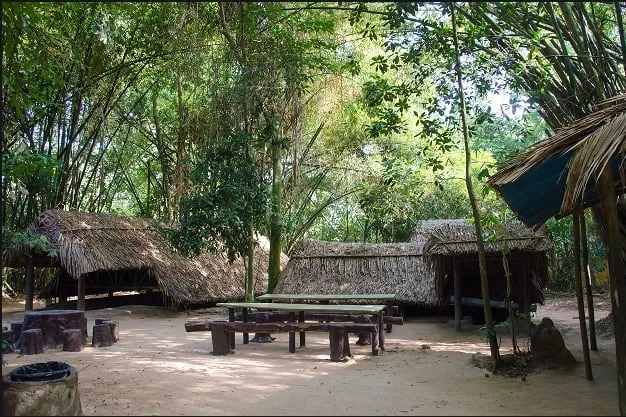Contents
ToggleWhere is Hoi An Located?
Hoi An is situated along the central coast of Vietnam, in Quang Nam Province, just 30 kilometers south of Da Nang — the region’s largest city with an international airport — and approximately 3 hours by car from Hue, the former imperial capital. This strategic location places Hoi An at the heart of one of Vietnam’s most culturally and scenically rich areas.
Nestled between the Cham Islands and the Truong Son mountain range, Hoi An enjoys a stunning natural setting that combines lush greenery, riverside charm, and coastal beauty. Its proximity to both mountains and sea offers a perfect blend of nature and heritage, making it a favorite destination for travelers seeking both relaxation and discovery.
- To the East: You’ll find some of Vietnam’s most beautiful beaches, including An Bang Beach, known for its laid-back vibe and gentle waves, and Cua Dai Beach, a popular spot for sunbathing and seafood dining.
- To the West: The Thu Bon River meanders through the countryside, connecting Hoi An to tranquil rural villages, rice paddies, and traditional craft communities. A boat ride along this river offers a poetic and peaceful escape from the bustle of the town center.
Hoi An’s compact and walkable layout is another part of its charm. The Old Town — a UNESCO World Heritage Site — is best explored on foot or by bicycle, with lantern-lit streets, historic buildings, temples, and markets all within easy reach. The gentle pace of life and traffic-free areas create a safe and serene environment perfect for slow travel and immersive exploration.
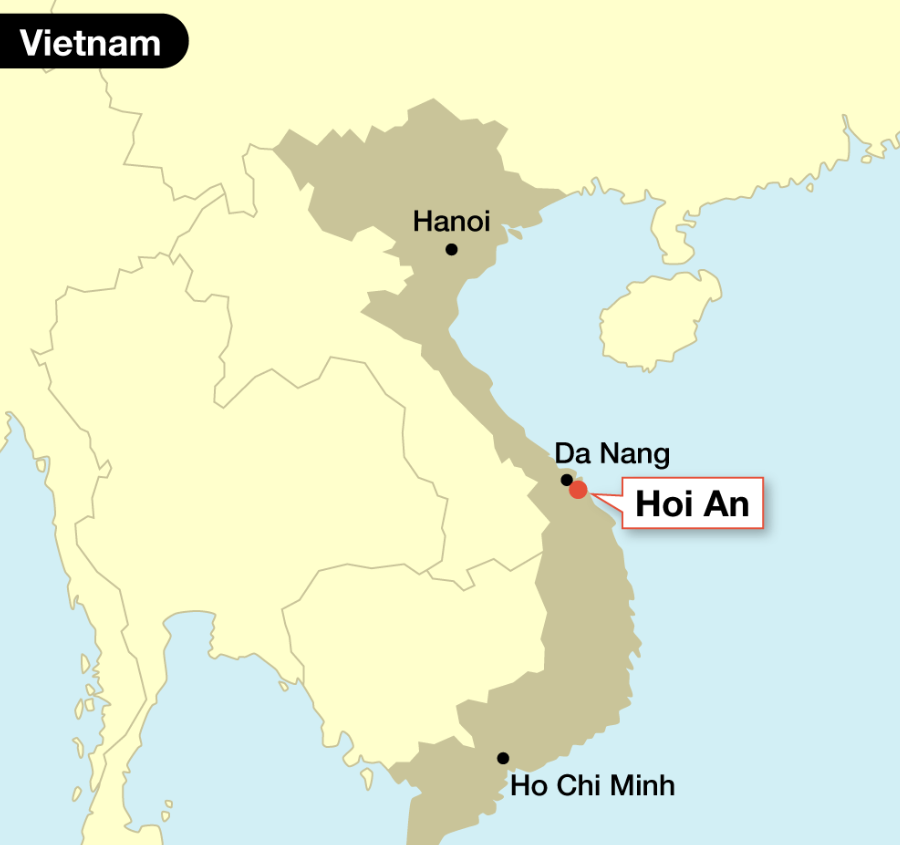
Essential Tips Before You Visit Hoi An
Planning ahead can make your visit to Hoi An even more memorable. Here are some key tips to help you get the most out of your stay:
1.1. Spend at Least 2 Days
While it’s possible to visit Hoi An on a day trip from Da Nang or Hue, you’ll only scratch the surface. To truly soak in the town’s charm, history, and relaxed pace, plan to stay at least 2 to 3 days. This allows you to:
- Explore the Ancient Town during both day and night (when the lanterns glow)
- Relax at nearby beaches like An Bang or Cua Dai
- Take a boat ride on the Thu Bon River
- Visit craft villages or take a local cooking class or bike tour into the countryside
A longer stay also gives you time to slow down and enjoy the peaceful atmosphere Hoi An is known for — something easily missed in a hurried itinerary.
1.2.Stay Near the Old Town
Hoi An is best experienced on foot or by bicycle, so your accommodation’s location matters.
- For convenience and cultural immersion, stay in or near Minh An Ward, which includes the UNESCO-listed Ancient Town. This area is perfect for walking, sightseeing, shopping, and dining, especially in the evenings when the lanterns light up the narrow streets.
- If you prefer a quieter environment or want to spend time at the beach, consider staying in Cam An Ward (close to An Bang Beach) or Cam Chau Ward, which lies between the beach and Old Town and offers peaceful homestays and lush surroundings.
Most accommodations — from boutique hotels to riverside resorts — offer free bicycles, making it easy to move between town, beach, and countryside.
1.3. Check the Weather
Hoi An has a tropical climate, so timing your visit can enhance your experience:
- Best beach weather: From mid-April to mid-August, you’ll enjoy hot, sunny days and calm seas — perfect for swimming and water activities.
- Rainy season: From September to December, Hoi An experiences frequent rain, higher humidity, and occasional flooding in the Old Town, especially in October and November. While the scenery can be atmospheric and the crowds thinner, some beach and river activities may be limited.
- Dry, cooler months: From January to March, temperatures are milder (18–24°C), and skies are often clear — great for cultural sightseeing, cycling, and photography.
Regardless of the season, Hoi An’s temples, museums, tailors, and cafes are enjoyable year-round, and there’s always a warm welcome waiting for you.
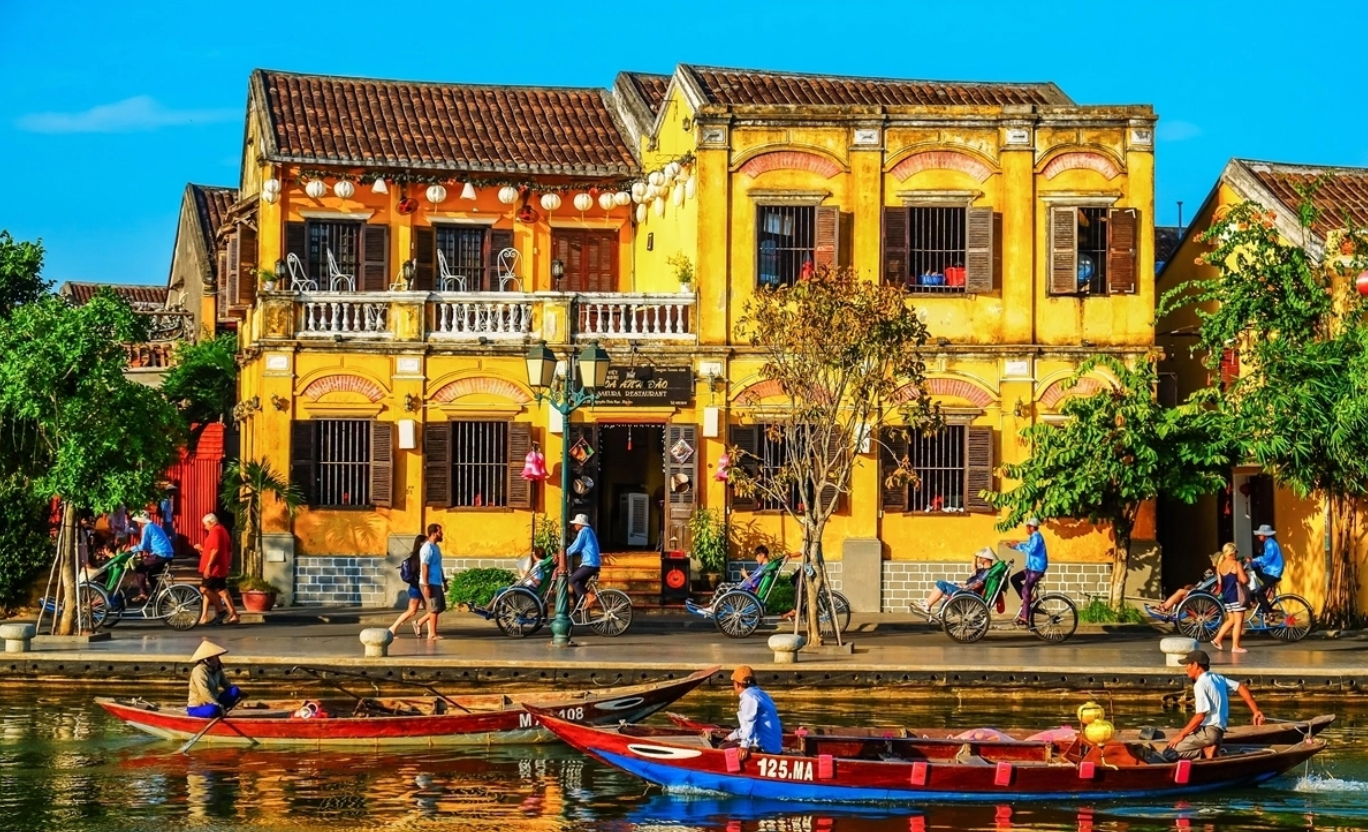
Top Things to Do in Hoi An
Hoi An is a captivating blend of cultural charm, riverside serenity, artisan heritage, and beachside bliss. Here are the top things to see and experience in this enchanting UNESCO World Heritage town:
- Wander Through Hoi An Ancient Town
Step into a living museum as you stroll or cycle through Hoi An’s narrow, lantern-lit streets. The Ancient Town is a beautifully preserved fusion of Vietnamese, Japanese, and European influences, where every corner reveals history and elegance.
Must-dos:
- Watch the sunset by the Hoai River
- Take a night boat ride and release floating lanterns
- Visit during a full moon for a magical, pedestrian-only atmosphere filled with music and candlelight
- Visit Hoi An’s Ancient Houses
These centuries-old merchant homes offer a rare window into traditional Vietnamese life and architecture.
Notable houses include:
- Tan Ky House – A national heritage site reflecting seven generations of history
- Phung Hung House – Showcasing rich Chinese and Japanese influences
- Quan Thang House – Elegant wood carvings and classic merchant interiors
- Duc An House – Once a bookshop and gathering place for revolutionaries
Each house blends Japanese beam structures, Chinese decor, and French colonial touches — a testament to Hoi An’s cosmopolitan past.
- See the Japanese Covered Bridge (Chùa Cầu)
Built in the 17th century by Japanese traders, this iconic wooden bridge is not just a tourist symbol — it’s a piece of living history. Featuring mythical dog and monkey statues, it also appears on Vietnam’s 20,000 VND banknote.
- Try Artistic Workshops
Get creative while connecting with Vietnamese heritage:
- The Timing Masks (66 Bach Dang St.): Make your own traditional tuồng (opera) mask
- Lantern-making classes in Cam Chau or Old Town
- Other crafts: calligraphy, silk painting, or woodblock printing
These hands-on experiences are both educational and uniquely personal.
- Explore Hoi An’s Museums
Hoi An’s museums offer fascinating insights into its trading legacy, cultural roots, and ethnic diversity.
Top picks:
- Hoi An Museum – Overview of the city’s development
- Sa Huynh Culture Museum – Prehistoric relics from early Cham civilization
- Museum of Trade Ceramics – Tracing Hoi An’s role in ancient Asian commerce
- Museum of Folk Culture – Local crafts, performances, and traditions
- Relax at An Bang Beach
Just a 15–20-minute bike ride from the Ancient Town, An Bang Beach was voted one of Asia’s Top 5 Beaches (Tripadvisor, 2024). With clean white sand, gentle waves, and cozy beach cafés, it’s perfect for sunbathing, swimming, or sipping a cocktail at sunset — especially between February and September.
- Visit Traditional Villages Near Hoi An
Hop on a bike and discover Hoi An’s artisanal soul in its nearby villages:
- Tra Que Village – Famous for organic farming and cooking classes
- Thanh Ha Pottery Village – Try your hand at shaping clay the traditional way
- Cam Chau and Cam Thanh – Known for lantern-making and eco-tourism
These villages offer immersive experiences and the chance to interact with local artisans in a meaningful way.
- Take a Day Trip to the Cham Islands (Cù Lao Chàm)
Located just 20 km offshore, the Cham Islands are a protected UNESCO Biosphere Reserve with crystal-clear waters, coral reefs, and white-sand beaches. Ideal for:
- Snorkeling and diving
- Visiting local fishing villages
- Exploring ancient temples and marine conservation centers
Accessible via speedboat or eco-tours from Cua Dai Port.
- Discover Local Cuisine
Hoi An is a paradise for food lovers, known for its unique Central Vietnamese flavors.
Must-try dishes:
- Cao Lau noodles – Exclusive to Hoi An, made with water from ancient wells
- Mi Quang – Turmeric rice noodles with shrimp and pork
- Hoi An chicken rice – A local take on Hainanese chicken
- MOT herbal tea (150 Tran Phu St.) – A refreshing mix of lemongrass, lotus, cinnamon, and more, served in eco-friendly cups
Street food stalls, riverside restaurants, and family-run eateries are all part of the delicious journey.
- Join a Vietnamese Cooking Class
Hoi An is one of the best places in Vietnam for a hands-on cooking class. Most experiences include:
- A visit to a local market
- A boat ride or bike tour to a nearby village
- Hands-on instruction preparing dishes like spring rolls, pancakes, pho, or cao lau
These interactive classes are consistently rated among the top experiences in Vietnam.
- Watch the Hoi An Memories Show
Held at the Hoi An Impression Theme Park, this spectacular outdoor performance features:
- Over 500 performers, elaborate costumes, and dazzling stage effects
- Stories of Hoi An’s historical rise as a port city
While some visitors love its scale and visuals, others may prefer more emotionally driven shows like The Quintessence of Tonkin in Hanoi. Either way, it’s a unique nighttime experience.
- Explore Bay Mau Coconut Forest by Basket Boat
Just 10 minutes from the Old Town, Bay Mau Palm Forest offers a fun and scenic adventure through a lush mangrove ecosystem. Glide in a traditional round bamboo basket boat, often piloted by locals who perform spinning tricks and folk songs along the way.
Great for families, photographers, and anyone seeking a half-day nature escape.
- Get Tailor-Made Clothing
Hoi An is famous for its skilled tailors, with hundreds of shops offering custom clothing — often ready in 24 hours or less.
Popular tailored items:
- Suits, dresses, and coats
- Áo dài (traditional Vietnamese dress)
- Linen sets, jumpsuits, and leather goods
Tip: Bring photos of what you want or choose from samples in the shop. Bargain politely and allow time for fittings.
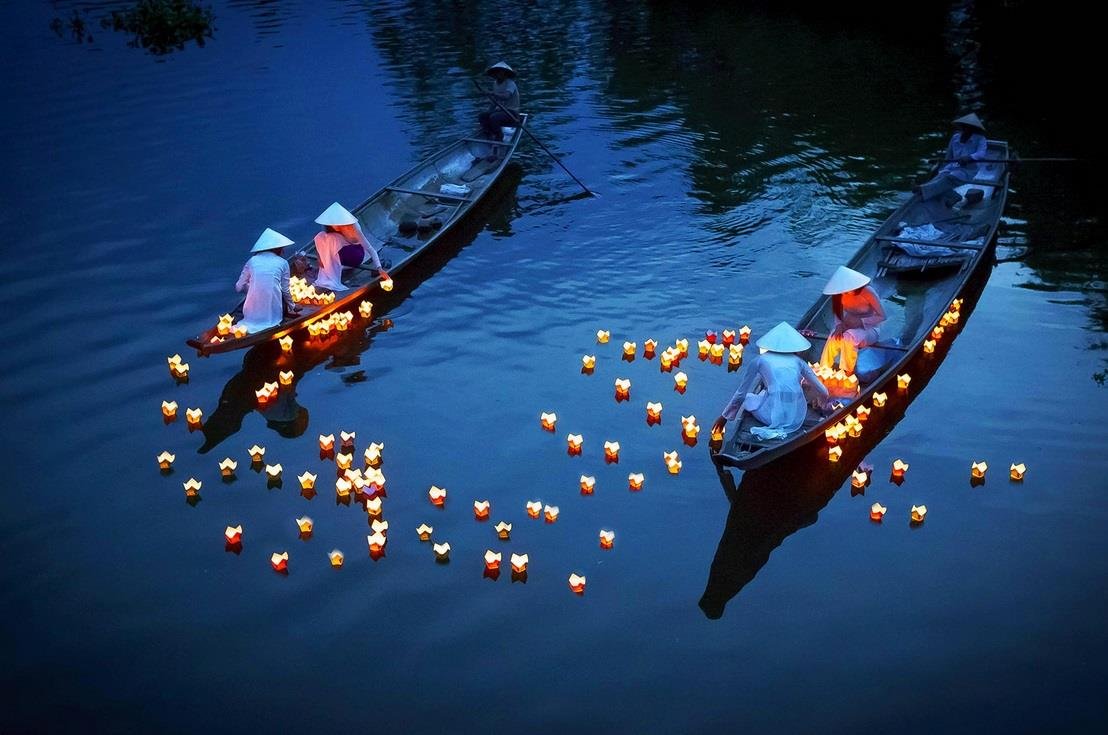
How to Get to Hoi An
While Hoi An does not have its own airport or train station, it is easily accessible via the nearby city of Da Nang, which serves as the main transportation hub for central Vietnam. Here are the best ways to reach Hoi An:
By Air
The most convenient way to reach Hoi An is by flying into Da Nang International Airport (DAD), located just 30 kilometers north of Hoi An. The airport receives numerous daily flights from:
- Hanoi and Ho Chi Minh City
- Major cities across Southeast Asia (e.g., Bangkok, Singapore, Kuala Lumpur, Seoul)
Once you land in Da Nang, you can get to Hoi An in about 45–60 minutes by:
- Private car or hotel transfer (fastest and most comfortable)
- Airport shuttle vans or ride-hailing apps like Grab
- Taxi (agree on the fare in advance or ensure the meter is running)
By Train
While Hoi An doesn’t have its own train station, you can travel to Da Nang Railway Station, a major stop on Vietnam’s north–south railway line.
- From Hanoi: ~16–18 hours
- From Ho Chi Minh City: ~15–19 hours
- From Hue: ~2.5–3 hours (a particularly scenic ride along the coast)
The journey offers stunning views of beaches, rice paddies, and mountains — especially the stretch between Hue and Da Nang.
After arriving at Da Nang Station, take a car, shuttle bus, or taxi to Hoi An. The ride typically takes 45 minutes to an hour.
Other Options
- By Bus or Van: Many open-tour buses and tourist vans operate between Hoi An and cities like Hue, Da Nang, or Nha Trang. These are budget-friendly and convenient.
- By Motorbike: For adventurous travelers, renting a motorbike from Da Nang or Hue allows for a scenic and flexible journey — especially along the famous Hai Van Pass.
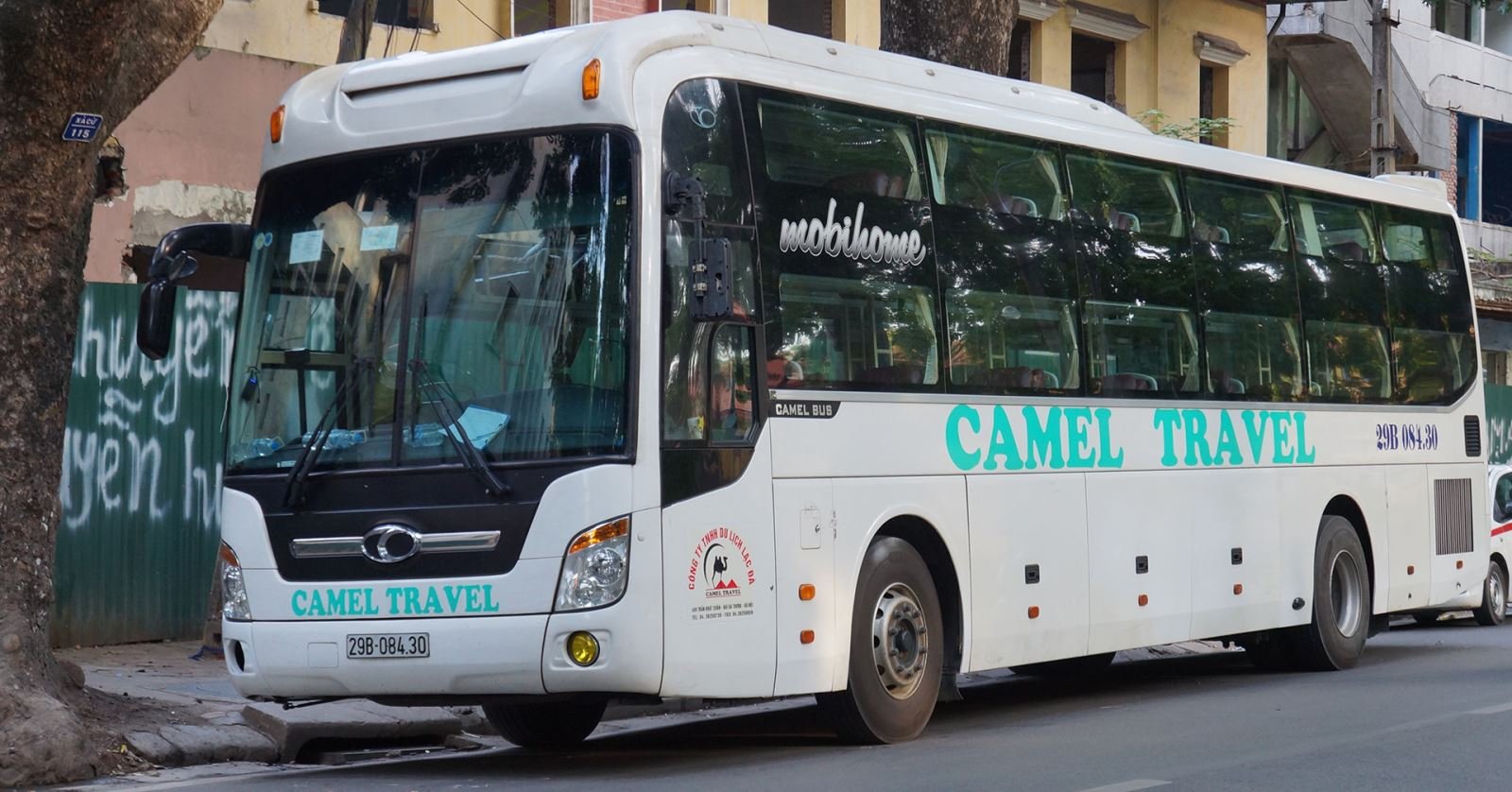
When is the Best Time to Visit Hoi An?
Hoi An is a year-round destination, but your experience can vary significantly depending on the season. The town has two main seasons — dry and rainy — each with its own pros and cons.
🌤 Dry Season (January to July)
This is the most popular and traveler-friendly time to visit Hoi An, especially from January to March, when the weather is cool, dry, and comfortable (average temperatures between 20–28°C). The skies are clear, humidity is low, and both beach and sightseeing activities are at their best.
Best time to visit:
- January to March – Ideal for exploring the Ancient Town, cycling, visiting craft villages, and enjoying An Bang Beach without extreme heat.
Good to know:
- April to July can get increasingly hot and humid, but are still great for sunbathing and swimming, with plenty of sunshine and minimal rain.
- Avoid April 30 – May 1, Vietnam’s Reunification Day and Labor Day holidays. This is one of the busiest domestic travel periods, with large crowds and high hotel demand.
🌧 Rainy Season (August to December)
From August through December, Hoi An enters its rainy season, with frequent showers, overcast skies, and the occasional typhoon or flood, particularly in October and November. During this time, the town’s rivers may rise and spill into the streets — transforming the Ancient Town into a Venice-like scene, with locals and visitors navigating by boat.
Pros:
- Fewer tourists, quieter streets, and a more romantic, moody atmosphere
- Discounts on accommodations and tours
- Great light for photography — the mist and rain give Hoi An a mystical charm
Cons:
- Outdoor activities like swimming, island trips, or beach visits may be limited
- Flash floods can temporarily close parts of the Old Town (though locals are well-prepared)
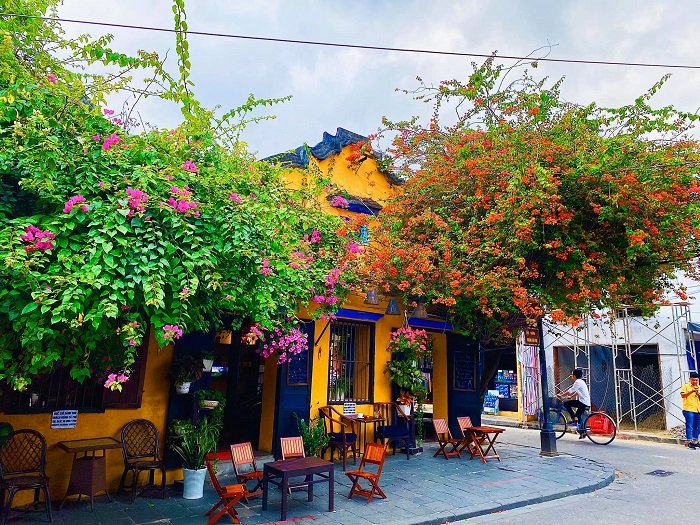
Suggested Itineraries for Hoi An
Whether you’re drawn by cultural heritage, natural beauty, or hands-on experiences, Hoi An offers a rich blend of activities to fill your days with meaning and charm. Here are two thoughtfully curated 3-day itineraries to help you make the most of your visit.
Itinerary 1: Heritage & Culture (3 Days)
Perfect for first-time visitors and history lovers seeking a balance of discovery and relaxation.
Day 1: Timeless Charm of the Ancient Town
- Wander through the UNESCO-listed Ancient Town, visiting landmarks like the Japanese Covered Bridge, Tan Ky House, and Fujian Assembly Hall
- Shop for handcrafted lanterns, ceramics, and tailor-made clothing
- Enjoy a riverside dinner, followed by a night boat ride with floating lanterns
Day 2: Village Life & Sunset Serenity
- Visit Thanh Ha Pottery Village or Cam Chau Lantern Village for a hands-on craft experience
- Take a bicycle ride through the countryside to Tra Que Herb Village
- Return to town for a sunset cruise on the Thu Bon River
Day 3: Beach or Cultural Extension
- Spend a relaxing morning at An Bang Beach — sunbathing or sipping coconut juice by the sea
- Optional full-day trip to Hue, Vietnam’s former imperial capital (3-hour drive), or relax with a spa treatment in Hoi An
Itinerary 2: Nature & Crafts (3 Days)
Designed for travelers who love immersive, eco-friendly experiences and hands-on cultural activities.
Day 1: Coconut Forest Adventure & Vietnamese Cuisine
- Start your day with a basket boat tour through the lush Bay Mau Coconut Forest
- Join a bamboo crafting or mask-making workshop
- In the afternoon, take a Vietnamese cooking class — many include a local market visit and countryside bike ride
Day 2: Farming and Folk Culture
- Visit Tra Que Village, where you can try your hand at organic vegetable farming and enjoy a farm-to-table lunch
- Return to town for some downtime, then explore the Ancient Town at night — take in the lanterns, street performances, or a traditional music show
Day 3: Spiritual Journey to My Son Sanctuary
- Take a morning trip to My Son Sanctuary (UNESCO site, ~1.5 hours from Hoi An) — an atmospheric collection of Cham temple ruins nestled in a jungle valley
- Return to Hoi An in the afternoon for shopping, coffee, or a sunset visit to the Japanese Bridge
✨ Travel Tip:
If you have more time, consider adding a Cham Islands snorkeling trip, a tailor-made clothing experience, or a visit to the Hoi An Memories Show for an unforgettable evening performance.
Hoi An is a place that invites slow exploration — so feel free to adapt these itineraries to match your pace and interests.
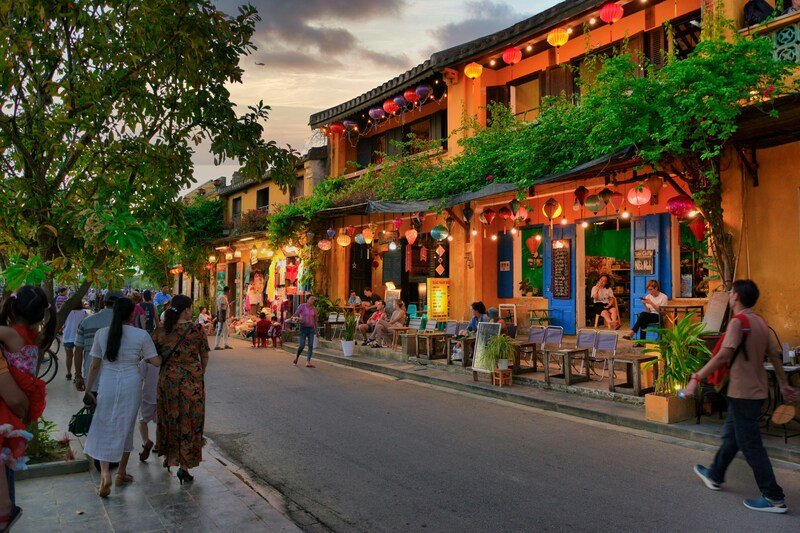
Where to Stay in Hoi An: Best Hotels for Every Traveler
Hoi An offers a wide range of accommodations — from riverside retreats to luxurious beach resorts. Here are four highly rated options that combine charm, comfort, and convenient access to the town’s top attractions.
🏡 Vinh Hung Riverside Resort
📍 Address: 111 Ngo Quyen, An Hoi
Nestled along the tranquil banks of the Thu Bon River, this resort is just a short stroll from the Ancient Town, making it perfect for those who want to explore on foot while enjoying peaceful surroundings.
Why stay here:
- Traditional architecture with a lush garden setting
- Riverside views and private balconies
- Free boat ride to nearby villages and local markets
🧘♂️ La Siesta Hoi An Resort & Spa
📍 Address: 132 Hung Vuong, Thanh Ha
A stylish and serene retreat located slightly outside the hustle of the Old Town, La Siesta combines luxury with personalized service. It’s an ideal base for relaxation, spa treatments, and resort-style comfort.
Why stay here:
- Four pools, including saltwater and infinity options
- On-site spa and excellent dining
- Shuttle service to Old Town and An Bang Beach
🏮 Little Hoi An Boutique Hotel & Spa
📍 Address: 02 Thoai Ngoc Hau
With its vintage Indochine decor and riverside setting, this boutique gem blends charming ambiance with modern comforts. Located steps away from Hoi An Market and the main attractions of the Old Town.
Why stay here:
- Elegant rooms with heritage-inspired interiors
- Warm, personalized service
- Ideal for couples and cultural travelers
🌴 Boutique Hoi An Resort
📍 Address: 34 Lac Long Quan, Cam Chau (Beachfront)
For travelers looking to enjoy the sun, sand, and sea, this beachfront resort offers elegant villas with private terraces just minutes from the Ancient Town. A perfect blend of beach holiday and cultural exploration.
Why stay here:
- Direct access to Cua Dai Beach
- Spacious villas surrounded by tropical gardens
- On-site spa, pool, and beachfront restaurant
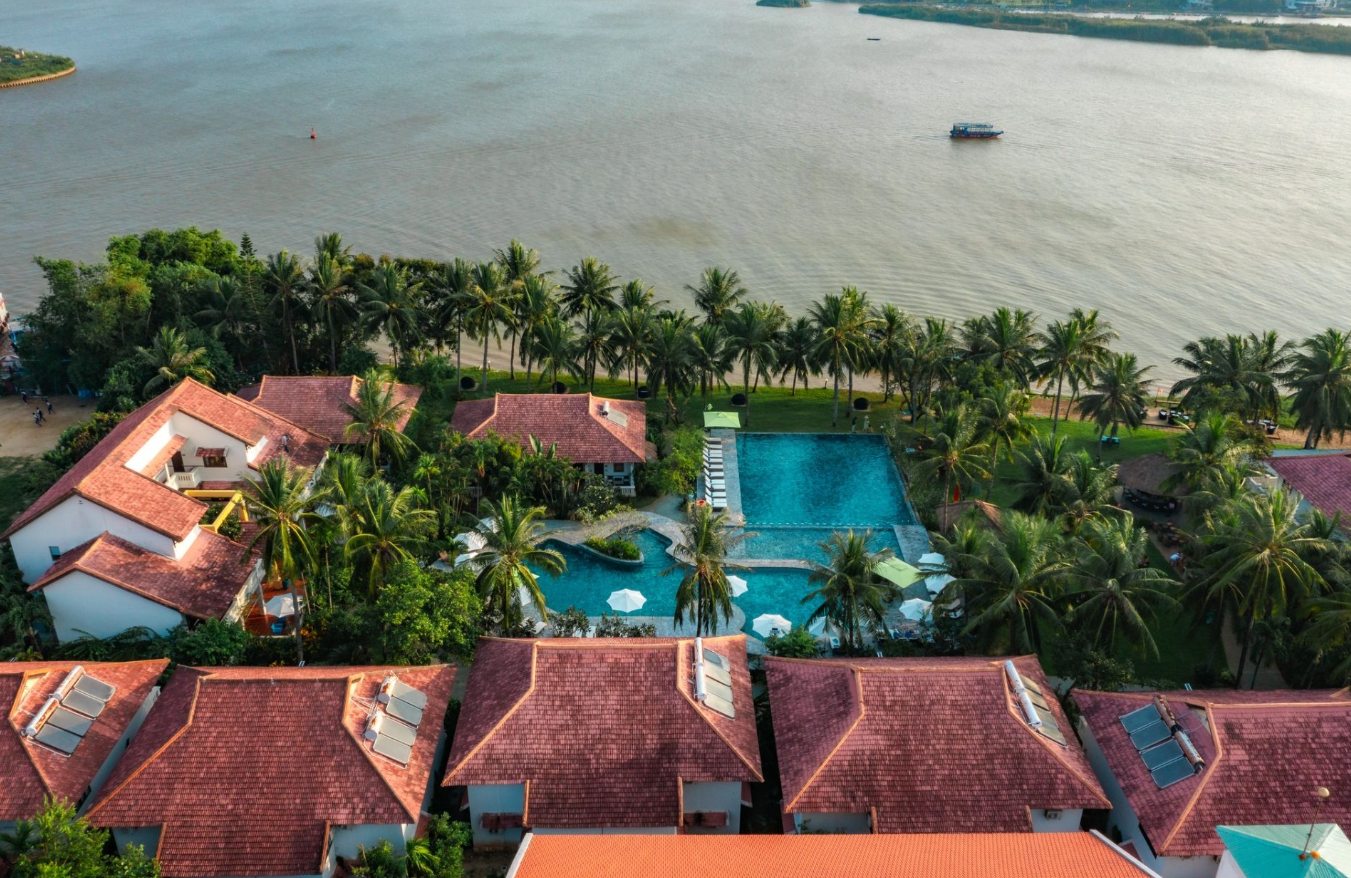
Final Thoughts: Discover the Magic of Hoi An
Hoi An is a town that enchants with its cultural depth, natural beauty, and relaxed lifestyle. From lantern-lit nights in the Old Town to lazy afternoons on the beach, it offers something for every traveler.
Whether you’re here for history, cuisine, art, or just a peaceful retreat, Hoi An promises an experience like no other.












